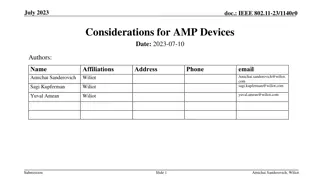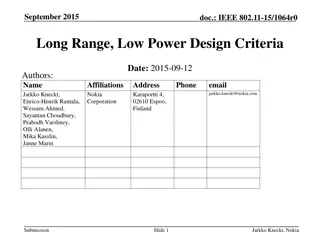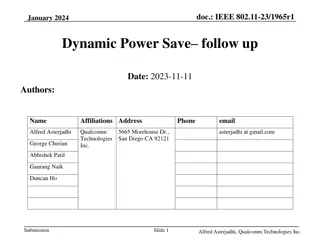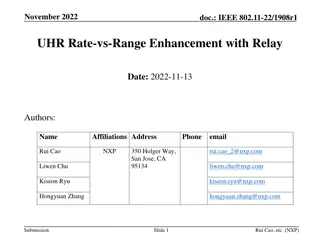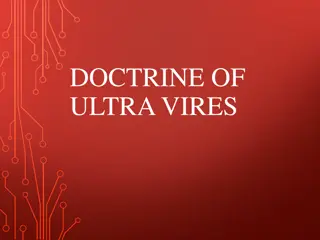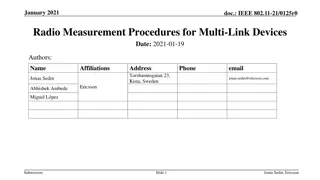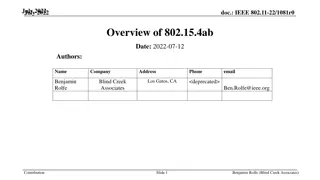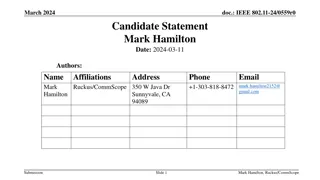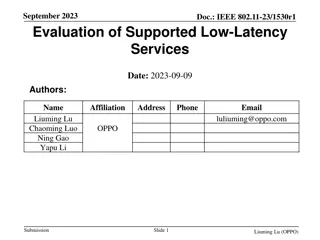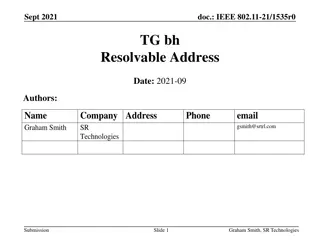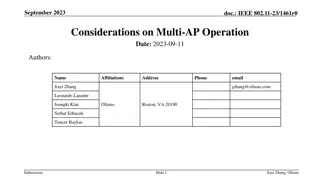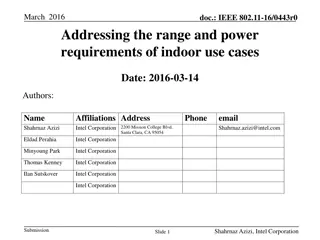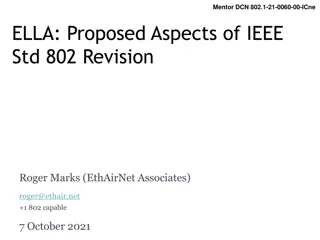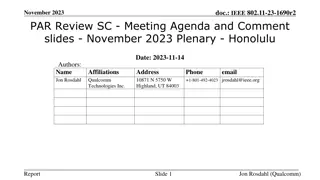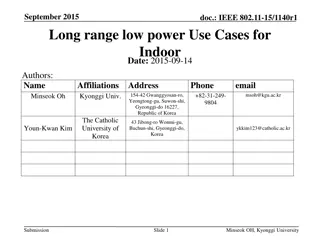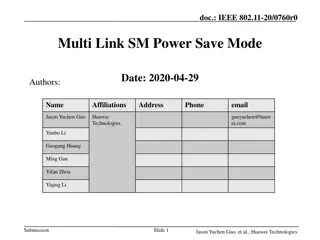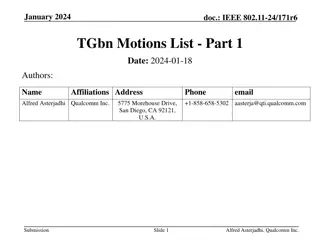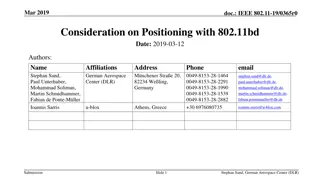Ultra Low Power Features for Active Devices in IEEE 802.11-24
This presentation discusses ultra low power features for active devices in IEEE 802.11-24, focusing on solutions for RF-harvesting AMP-only and AMP-assisted devices. It covers capabilities requirements, device solutions, and implementations such as constant envelope waveform, control and sensing capabilities, and limited payload for RF energy harvesting devices. The aim is to enable the market for 802.11bp by providing efficient and low-power transmission options.
Download Presentation

Please find below an Image/Link to download the presentation.
The content on the website is provided AS IS for your information and personal use only. It may not be sold, licensed, or shared on other websites without obtaining consent from the author. Download presentation by click this link. If you encounter any issues during the download, it is possible that the publisher has removed the file from their server.
E N D
Presentation Transcript
July 2024 doc.: IEEE 802.11-24/1253r0 Ultra Low Power Features For Active Devices Date: 2024-07-14 Authors: Name Amichai Sanderovich Solomon Trainin Affiliations Wiliot Address Phone email Amichai.sanderovic h@wiliot.com solomon.trainin@w iliot.com penny.efraim.sagi@ wiliot.com Wiliot Penny Efraim-Sagi Wiliot Amichai Sanderovich, Wiliot Submission Slide 1
July 2024 doc.: IEEE 802.11-24/1253r0 Abstract In this presentation we would like to discuss some ultra low power features for active devices Submission Slide 2 Amichai Sanderovich, Wiliot
July 2024 doc.: IEEE 802.11-24/1253r0 Recap on Suggested Devices for 802.11bp In [1] 4 solutions were envisioned to enable market for 802.11bp Solution 1: active transmission; Solution 2: close range backscatter with full duplex; Solution 3: long range backscatter with bi-static; Solution 4: legacy 802.11 devices enhanced with AMP features, e.g., extremely low power consumption, energy harvesting capability In [3], two devices were clearly defined: RF-harvesting AMP-only device was defined to be one with <1mW AMP-assisted device with <10-100mW Solution 1-3 from [1] are for RF-harvesting AMP-only device while Solution 4 from [1] is only for AMP-assisted device - as defined in [3] In this presentation we would like to provide some capabilities requirements for Solution 1 for RF-harvesting AMP-only device (active transmission) Submission Slide 3 Amichai Sanderovich, Wiliot
July 2024 doc.: IEEE 802.11-24/1253r0 Ultra Low Power Features for RF-Harvesting AMP Only Active Devices CFO/SFO PPM 1e3 Device/Solution Active (S1) UL Waveform CE MAC Capabilities Control + Sense, ID Range 50m Ultra low power consumption can be 100s-10s uW CE Constant Envelope Waveform (OOK, FSK , PSK) Submission Slide 4 Amichai Sanderovich, Wiliot
July 2024 doc.: IEEE 802.11-24/1253r0 Active Transmission Devices (S1) These devices are expected to work out of RF energy harvesting (zero energy) These devices are expected to fit into a sticker or a tag form factor and cost Some features that enable 802.11bp expectations were discussed [1-3] Clock can be implemented without a crystal - with fast, simple & efficient internal circuits that can reach e.g. 1000ppm Constant envelope transmission is easy to implement using highly efficient non-linear components Limited payload to ID plus some additional sensing and control information Only trigger based traffic (no device originated traffic) Limited message length/types and waveform reception processing capabilities Very simple functionality that requires minimal processing/memory Uplink data rate of few Mbps allows lower energy and longer range for RF harvesting devices Submission Slide 5 Amichai Sanderovich, Wiliot
July 2024 doc.: IEEE 802.11-24/1253r0 Recap for 1000ppm Active TX Advantage From [2] For active transmitter AMP-STAs, we would like to reduce the need for a crystal based stable clock with accuracies in the orders of 40ppm Stable crystal-based clocks usually consume non-neglectable power and also take some time to turn on, until reaching stability In addition, they require an external component on top of the silicon chip. Requiring a crystal results in excessive complexity and power consumption, which limits massive deployments with a sticker form factor Depending on exact system design, it is possible to use a simpler, lower power, internal oscilators (see ref. 1-3 in [2]). Such oscilators are usually characterized with lower clock accuracies. However, by using various internal low power calibrations based on temperature and process, they can reach an accuracy of 1000ppm without needing a crystal Submission Slide 6 Amichai Sanderovich, Wiliot
July 2024 doc.: IEEE 802.11-24/1253r0 Example for 1000ppm Uplink Spectrum Impact 1000ppm over the 2.4 channel (2.4-2.48GHz) results with frequency ambiguity of no more than 2.48MHz [4.98MHz]. Several options are possible to fit the 20MHz channel depending on data-rates Possible Transmission BW [MHz] 1 4 8 16 # of 802.11bp FDM channels 3 2 1 1 Total occupied band [MHz] 17.88 17.92 12.96 20.96 Submission Slide 7 Amichai Sanderovich, Wiliot
July 2024 doc.: IEEE 802.11-24/1253r0 MSK BLER with CFO = 1000ppm vs CFO = 40ppm Example for 1000ppm Uplink RX Impact 10-1 As uplink receiver is less limited, estimating a 1000ppm CFO can be done by many approaches We checked one examplary approach of autocorrelation (1 complex multiplication) By using L data symbles (no special preambles in this approach) simulations suggest we can reach sufficient performance More study is required to determine the exact modem requirements and if we need additional preambles or increased reader Trx2tx (SIFS) time. BLER 10-2 MSK random impairments (uniform CFO MSK random impairments (uniform CFO 40ppm) 1000ppm) 10-3 7.5 8 8.5 9 9.5 10 10.5 11 SNR [dB] STD of autocorrelation CFO estimation 100 MSK (L=16) MSK (L=24) MSK (L=32) MSK (L=40) OOK (L=16) OOK (L=24) OOK (L=32) OOK (L=40) STD [ppm] 50 0 4 6 8 10 12 14 SNR [dB] Submission Slide 8 Amichai Sanderovich, Wiliot
July 2024 doc.: IEEE 802.11-24/1253r0 Modes of Operation of AMP Devices Active devices that operate on ultra low power mode reach ultra low complexity and can achieve energy harvesting (zero power) AMP-assisted legacy devices can operate in both ultra low power mode and low power mode - thus save power/complexity based on application This requires to focus on new ultra low power mode in the 802.11bp amandmant Submission Slide 9 Amichai Sanderovich, Wiliot
July 2024 doc.: IEEE 802.11-24/1253r0 SP#1 Do you agree that 11bp defines at least one mode of MAC/PHY that support active transmission in 2.4GHz for AMP-only RF-harvesting device? Yes No Abstain Submission Slide 10 Amichai Sanderovich, Wiliot
July 2024 doc.: IEEE 802.11-24/1253r0 SP#2 Do you agree that 11bp defines at least one PHY/MAC mode that allows crystaless devices to actively transmit? Yes No Abstain Submission Slide 11 Amichai Sanderovich, Wiliot
July 2024 doc.: IEEE 802.11-24/1253r0 SP#3 What clock accuracy can active devices use on 2.4GHz? a) 1000 ppm b) 2000 ppm c) 10,000 ppm d) abstain Submission Slide 12 Amichai Sanderovich, Wiliot
July 2024 doc.: IEEE 802.11-24/1253r0 SP#4 Do you agree that 11bp defines at least one mode of MAC/PHY with clock offset requirement of 1000ppm for the uplink active transmission at 2.4GHz? Yes No Abstain Submission Slide 13 Amichai Sanderovich, Wiliot
July 2024 doc.: IEEE 802.11-24/1253r0 References [1] 11-24-0849-01-00bp-harmonization-of-waveform [2] 11-23-1140-00-0amp Considerations for AMP Devices [3] 11-23-0436-00-0amp-technical-report-on-support-of-amp-iot-devices-in- wlan Submission Slide 14 Amichai Sanderovich, Wiliot


